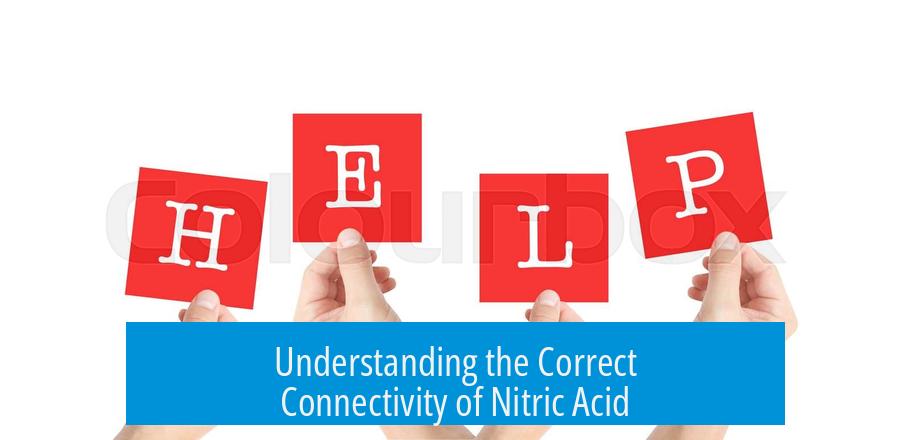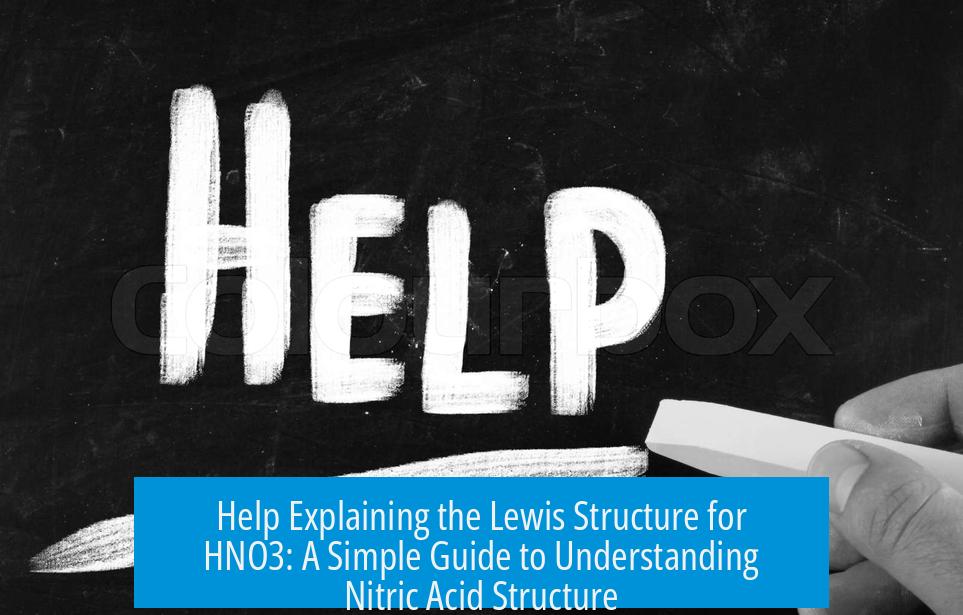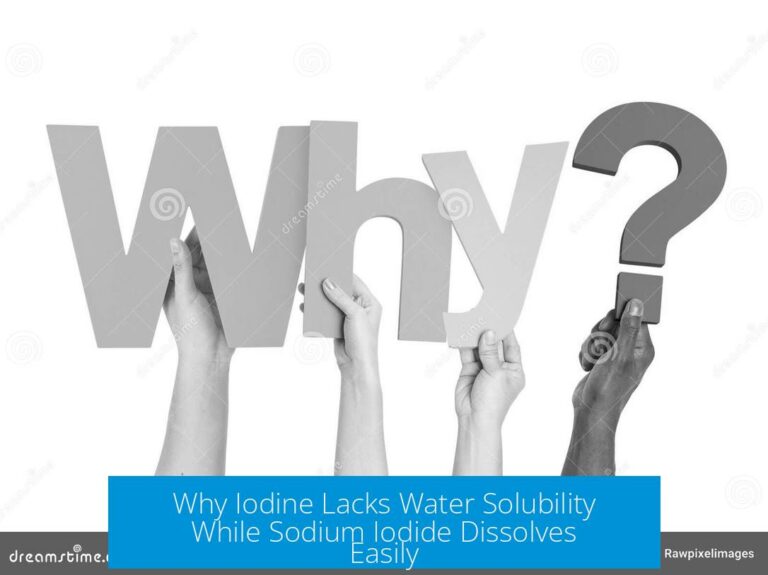Help Explaining the Lewis Structure for HNO3

The Lewis structure of nitric acid (HNO3) is best represented as a nitrate ion (NO3−) bonded to a proton (H+), with the nitrogen atom at the center connected to three oxygen atoms—one through an O-H bond and the others via single and double bonds—forming a resonance-stabilized structure. This connectivity, confirmed by experimental evidence, distinguishes HNO3 from peroxide-like or HOONO structures.
Understanding the Correct Connectivity of Nitric Acid

Nitric acid’s molecular formula is HNO3, but atomic connectivity matters for depicting its Lewis structure accurately.
- The correct structural formula is HONO2, reflecting the arrangement (O=)2N–O–H.
- This arrangement is confirmed by X-ray crystallography and gas-phase studies.
- Alternative structures such as HOONO or peroxide-like O–O bonds are incorrect for nitric acid.
Thus, in the Lewis structure, the nitrogen atom exists centrally, bonded directly to three oxygen atoms, with one oxygen also bonded to hydrogen.

Experimental Evidence Supporting the Structure
- X-ray Crystallography and Gas Phase Data: These methods reveal atomic positions unambiguously, supporting the nitrogen-centered structure with no peroxide (O–O) linkage.
- Dissociation Behavior in Water: Nitric acid dissociates into protons (H+) and nitrate ions (NO3−). This is consistent with the Lewis structure depicting a proton attached to a nitrate ion.
- Ion Geometry: Observed nitrate ions show trigonal symmetry, matching NO3−, rather than bent shapes expected from peroxide or ONOO-like ions.
- Metal Carbonate Reactions: Experiments with metal carbonates and nitric acid produce crystals containing trigonal nitrate ions, confirmed by X-ray, further validating the structure.
Why HNO3 Does Not Contain Peroxide-Like O–O Bonds

O–O single bonds characterize peroxides and give rise to unique chemical properties like free radical formation.
- No peroxide-like behavior is observed in nitric acid.
- Nitric acid shares oxidizing characteristics due to nitrogen’s high oxidation state, not due to O–O bonds.
- HOONO, a peroxide-containing compound, differs substantially in both color and chemical behavior from nitric acid.
Steps to Draw the Lewis Structure of HNO3

Step 1: Calculate Total Valence Electrons
Count valence electrons for each atom:

| Atom | Quantity | Valence Electrons per Atom | Total Valence Electrons |
|---|---|---|---|
| Hydrogen (H) | 1 | 1 | 1 × 1 = 1 |
| Nitrogen (N) | 1 | 5 | 1 × 5 = 5 |
| Oxygen (O) | 3 | 6 | 3 × 6 = 18 |
| Total | 24 |
Step 2: Identify the Central Atom
Nitrogen is less electronegative than oxygen and is placed at the center. The three oxygen atoms, including one hydroxyl group (O–H), surround nitrogen.
Step 3: Form Single Bonds
- Create single bonds (electron pairs) between nitrogen and each oxygen atom.
- Create a single bond between one oxygen atom and hydrogen (the hydroxyl group).
Step 4: Complete Octets on Outer Atoms
Distribute remaining electrons to fill the octet of oxygen atoms (except hydrogen, which requires 2 electrons).
Step 5: Complete Nitrogen’s Octet
To satisfy nitrogen’s octet, convert a lone pair from one oxygen atom to form a double bond with nitrogen.
Step 6: Verify Formal Charges and Structure Stability
| Atom | Valence Electrons | Nonbonding Electrons | Bonding Electrons/2 | Formal Charge |
|---|---|---|---|---|
| Nitrogen | 5 | 0 | 4 (8 bonding e− / 2) | 5 – 0 – 4 = +1 |
| Oxygen (double bonded) | 6 | 4 | 2 (4 bonding e− / 2) | 6 – 4 – 2 = 0 |
| Oxygen (single bonded to N) | 6 | 6 | 1 (2 bonding e− / 2) | 6 – 6 – 1 = -1 |
| Oxygen (hydroxyl group, bonded to H) | 6 | 4 | 2 (4 bonding e− / 2) | 6 – 4 – 2 = 0 |
| Hydrogen | 1 | 0 | 1 (2 bonding e− / 2) | 1 – 0 – 1 = 0 |
The overall charge of the nitrate ion is -1, balanced by the +1 charge of the attached proton, resulting in a neutral molecule. This balance supports the Lewis structure’s stability.
Representation of Bonds and Electron Pairs
The Lewis structure shows electron pairs between atoms as single or double bonds:
- A single bond represents a shared pair of electrons (two dots or a line).
- A double bond represents two shared pairs (four dots or a double line).
In HNO3, there is one double bond between nitrogen and an oxygen, two single bonds to the other oxygens, one of which bonds to hydrogen, forming the hydroxyl group.
Understanding Resonance in HNO3
The nitrate portion exhibits resonance with multiple valid Lewis structures. The double bond between nitrogen and oxygen can shift among the oxygen atoms, delocalizing electron density.
- Resonance stabilizes the ion, explaining equivalent N–O bond lengths observed experimentally.
- It accounts for the partial double bond character across all N–O bonds.
Common Student Misconceptions
Students may confuse nitric acid’s structure with that of peroxides or HOONO (hydroperoxynitrite). Key distinctions include:
- HOONO has an O–O bond and exhibits different color and reactivity than HNO3.
- HNO3 does not contain an O–O bond; peroxide-like arrangements are chemically inconsistent with observations.
- Nitric acid acts as proton donor to nitrate ions, fitting the Lewis structure of HNO3 as protonated nitrate.
Summary of the Lewis Structure for HNO3
| Feature | Description |
|---|---|
| Molecular Formula | HNO3 |
| Central Atom | Nitrogen |
| Bonding | One N=O double bond; two N–O single bonds; one O–H single bond |
| Electron Regions Around N | Three regions: two oxygen atoms and one hydroxyl group |
| Formal Charges | +1 on nitrogen; -1 on one oxygen; charge balance results in neutral molecule |
| Resonance | Multiple resonance forms; delocalized electrons across N–O bonds |
| Confirmed by | X-ray crystallography, gas-phase studies, chemical behavior |
Key Takeaways
- HNO3 consists of a central nitrogen atom bonded to three oxygens; one oxygen bonded to hydrogen.
- The nitrogen has one double bond and two single bonds to oxygen atoms.
- The Lewis structure reflects a protonated nitrate ion, with resonance stabilization.
- Experimental data confirms no O–O peroxide bonds in nitric acid.
- Formal charges balance, supporting the stability of this Lewis structure.
- Misinterpretation as HOONO or peroxide is incorrect based on chemical and physical evidence.
Help Explaining the Lewis Structure for HNO3: A Clear and Fun Guide
So, how do you draw the correct Lewis structure for HNO3 (nitric acid)? Simply put, the correct connectivity is HONO2, meaning that the nitrogen atom bonds to two oxygens (via one double bond and one single bond), and the third oxygen carries a hydrogen atom (forming an O-H group). Nitric acid is best represented as (O=)2N–O–H, not as HOONO or other peroxide-like structures.
Sounds simple enough? Well, let’s dive deep to understand why this structure matters, what evidence backs it, and how to draw it confidently. Along the way, you’ll see why some alternative structures just don’t hold water (or acid!).
What Makes HONO2 the Real Deal?
One might wonder, “Why not draw HNO3 as HOONO or something more exotic?” That’s where experimental science shines. Researchers have used X-ray crystallography and gas-phase molecular analysis to pinpoint exactly how atoms connect in nitric acid molecules. The data show conclusively that nitric acid’s architecture is (O=)2N–O–H. This means we have a nitrogen atom centralized, double bonded to two oxygens, and single bonded to an oxygen that carries a hydrogen.
Unlike HOONO, which resembles a peroxide (with an oxygen-oxygen bond), HNO3 avoids the O-O bond entirely. Peroxides always have these O-O connections, which bring along specific chemical properties nitric acid doesn’t share.
How Chemistry and Experiments Confirm the Structure
Why trust the NO3 + H model? Because nitric acid dissociates in water to release protons (H+) and nitrate ions (NO3−). If HNO3 had a peroxide linkage or formed something like ONOO− upon dissociation, the chemistry and behavior would differ dramatically.
Pro tip: When dissolved, nitric acid acts just like a proton buddy handing off a nitrate ion as its partner.
Moreover, the nitrate ion is trigonal planar and symmetrical, which matches the experimentally observed geometries. Alternative structures would skew this symmetry or form bent molecules that simply aren’t seen.
Trying a small experiment? Dissolve a metal carbonate in nitric acid, evaporate the water, and check the solid with X-ray crystallography. You’ll observe trigonal nitrate ions as expected — no O-O bonds or weird oxidizers here.
Peroxide Linkages? Not in This Party!
O-O (oxygen-oxygen) bonds often make chemists raise their eyebrows. They hint at peroxides or similar reactive species. Nitric acid has strong oxidizing capacity, like peroxides, but that’s due to nitrogen’s high oxidation state, not these bonds.
This is critical. If HNO3 had peroxide bonds, it would behave like free radical initiators—super reactive and unstable under common conditions. But nitric acid is more controlled and predictable.
Also, different compounds like HOONO, which actually contain O-O bonds, differ noticeably in properties: their solutions look orange-red and can oxidize bromide ions to bromine (Br2), unlike nitric acid, which is clear and doesn’t have that capability.
The Nitty-Gritty of Lewis Structures: How To Draw HNO3 Correctly
Let’s give you a friendly step-by-step guide to drawing the Lewis structure of nitric acid.
- Count the total valence electrons: Nitrogen has 5, each oxygen has 6 (3 x 6 = 18), and hydrogen has 1. Total: 5 + 18 + 1 = 24 valence electrons.
- Choose the central atom: Nitrogen is less electronegative than oxygen, so it takes center stage.
- Arrange bonds: Start by connecting nitrogen to three oxygen atoms—two with single bonds and one which will connect to hydrogen. Add single bonds between O and H for the hydroxyl part.
- Complete octets for outer atoms: Fill the remaining electrons around the oxygen atoms to satisfy their octets.
- Complete the nitrogen octet: Check if nitrogen has eight electrons. If not, create a double bond by moving a lone pair from one oxygen to bond with nitrogen.
- Calculate formal charges: Use the formula: Formal charge = Valence electrons – Nonbonding electrons – (Bonding electrons/2) You’ll find nitrogen carries a +1 charge, balanced by an oxygen with a -1 charge. They neutralize each other, giving a stable overall molecule.
Important tip: Avoid making the double bond with the oxygen attached to hydrogen (OH group) because that would create extra charges and instability. Instead, form the double bond with one of the other oxygens, resulting in the most stable structure.
Visualizing Bonds: From Electron Pairs to Lines
Each electron pair between atoms represents a bond. So in Lewis structures:
- 1 electron pair (:) = single bond (-)
- 2 electron pairs (::) = double bond (=)
In HNO3, you have one nitrogen-oxygen double bond and two nitrogen-oxygen single bonds. One oxygen is linked to hydrogen via a single bond.
Why Formal Charges Matter
Sometimes, Lewis structures look odd with +1 or -1 charges on atoms. But when these charges cancel out overall, the molecule is quite stable. In nitric acid’s case, the positive charge on nitrogen perfectly balances the negative charge on an oxygen atom, achieving a neutral molecule overall.
Don’t worry if this charge juggling seems complicated. It’s simply nature’s way of balancing electrons for chemical happiness.
Connecting the Dots: Personal Experience with Lewis Structures
Many chemistry students stumble here. I recall tutoring a student who drew an O-O bond in nitric acid. I said, “Cool idea, but nature doesn’t always play with we humans’ imagination.” After reviewing experimental data and chemical properties, they visualized the concept better.
The trick? Start by asking: “Does the molecule behave like it has a peroxide bond? Does it generate free radicals?” If the answer’s no, rethink your Lewis structure.
A Quick Comparison to Make It Stick
| Feature | HOONO (Peroxynitrous Acid) | HNO3 (Nitric Acid) |
|---|---|---|
| O-O bond | Yes | No |
| Color of solution | Orange-red | Clear |
| Oxidizes bromide to Br2 | Yes | No |
| Charge on Nitrogen | Neutral | +1 (balanced by oxygen) |
| Ions produced in water | Peroxynitrite (ONOO−) | Nitrate (NO3−) + H+ |
This table highlights the stark differences—two molecules with somewhat similar formulae but totally different structures and chemical behaviors. Clear evidence shows nitric acid is not HOONO or any peroxide-like compound.
Summary: Why Getting This Right Matters
Understanding the Lewis structure of HNO3 is more than just a homework task. It clarifies nitric acid’s chemical behavior, reactivity, and role in processes from laboratories to environmental chemistry. The correct structure:
- Shows a nitrogen center with two double bonds and one single bond to oxygen, plus an O-H bond.
- Matches experimental evidence from X-ray crystallography.
- Explains nitric acid’s dissociation into protons and nitrate ions.
- Distinguishes nitric acid from similar but chemically different molecules like HOONO.
- Helps predict reactivity and interactions with other chemicals.
Next time you see HNO3, think HONO2 with no tricky O-O bonds. You’re envisioning a molecule backed by solid research and reliable chemistry!
One Last Thought: Teaching Tip
Students often need firm guidance on this topic. Don’t hesitate to say, “Here’s the real connectivity of nitric acid: (O=)2N–O–H.” It saves future confusion, especially when the names and formulas alone can mislead.
Once you have this base, drawing and understanding Lewis structures become far easier—and maybe, just maybe, chemistry gets a little less puzzling.
Why is the Lewis structure for HNO3 shown as HONO2 and not HOONO?
HNO3’s true connectivity is HONO2, based on X-ray and gas phase studies. The HOONO form suggests an O-O bond that nitric acid does not have. Experiments confirm the nitrate ion geometry fits HONO2, not peroxide-like structures.
How does the charge distribution work in the HNO3 Lewis structure?
Nitrogen has a +1 formal charge due to double bonds with oxygens. Oxygens balance this with -2 charges overall, forming the nitrate ion NO3⁻. The proton (H⁺) balances the charge, making the entire molecule neutral.
Why does HNO3 not have an O-O peroxide bond like HOONO?
O-O bonds appear mainly in peroxides, which show different chemical behaviors. Nitric acid does not show peroxide properties such as free radical initiation. Instead, its oxidizing power comes from the nitrogen’s high oxidation state.
What experimental evidence supports the accepted Lewis structure of nitric acid?
X-ray crystallography and gas-phase molecule studies provide direct evidence. Also, reactions with metal carbonates reveal nitrate ions with trigonal symmetry, matching the HONO2 structure rather than molecules with O-O bonds.
How does nitric acid dissociate in water related to its Lewis structure?
It dissociates into a proton (H⁺) and nitrate ion (NO3⁻). This matches the Lewis structure where an H is attached to an oxygen on the nitrate ion. The dissociation supports the HONO2 form, not structures that would lead to ONOO⁻ ions.





Leave a Comment